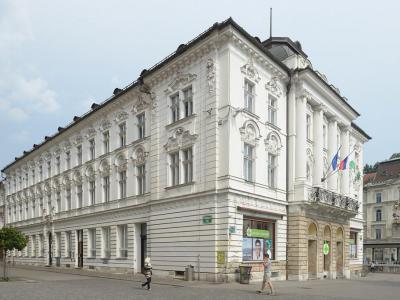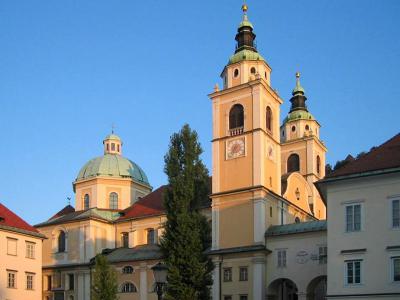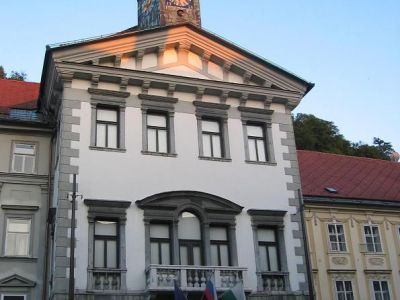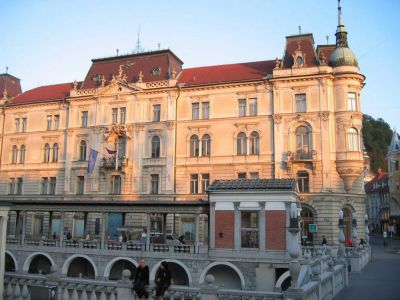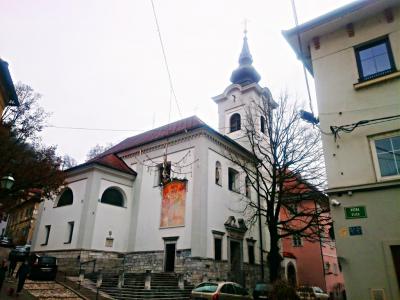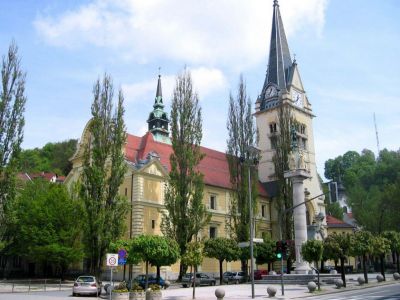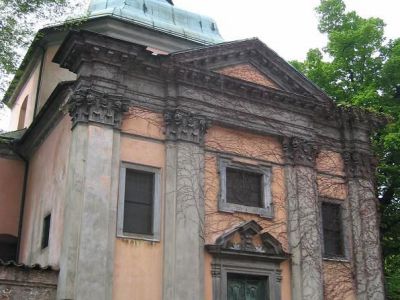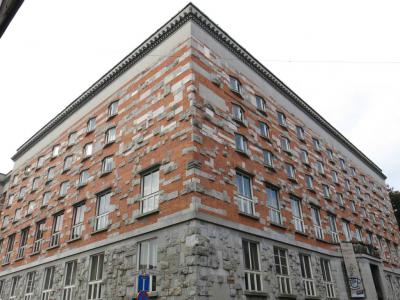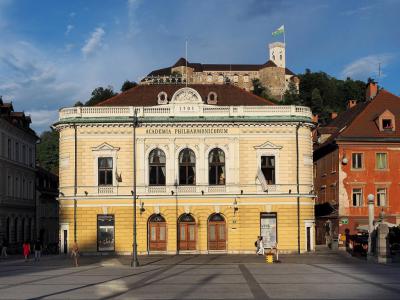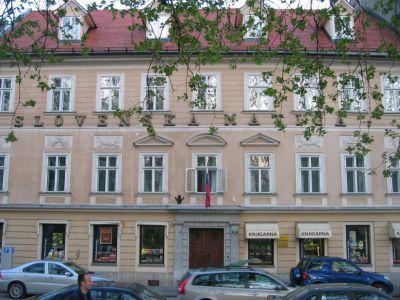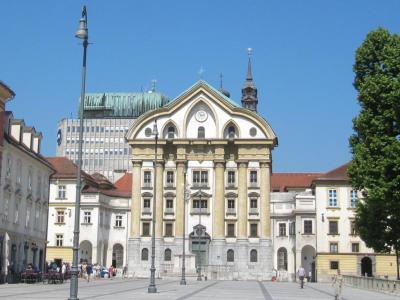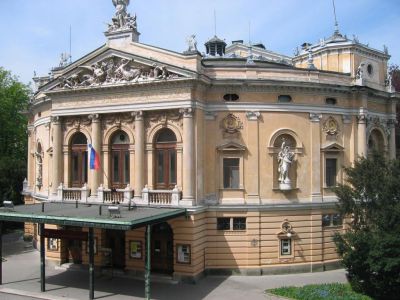Historic Buildings Walking Tour (Self Guided), Ljubljana
The Slovenian capital has no shortage of historical buildings. The architectural wealth of Ljubljana accumulated over the years received a significant boost in the early 20th century thanks to the famous Slovenian architect, Joze Plecnik, a classicist, who tried to model the city on ancient Athens.
Among the notable local landmarks is the Ljubljana Central Pharmacy, a testament to the city's longstanding tradition of healthcare, and the Ljubljana Cathedral, commonly known as Stolnica Svetega Nikolaja, a prominent religious site and a striking example of Baroque architecture.
Ljubljana Town Hall, with its elegant façade and historic significance, is a focal point for civic affairs and cultural events. Kresija Palace, another architectural gem, showcases the grandeur of Neo-Rococo and houses administrative offices and cultural institutions.
In turn, Saint Florian's (Sentflorjanska Cerkev), Saint Jacob's (Sentjakobska Cerkev), Our Lady of Mercy (Krizanke Cerkev), and Holy Trinity (Cerkev Svete Trojice) churches exude serenity and spirituality, standing as testaments to Ljubljana's religious diversity and architectural prowess.
The National and University Library of Slovenia, a beacon of knowledge and learning, symbolizes the city's intellectual vitality. At the same time, the Slovenian Philharmonic, the Slovene Society (Slovenska Matica), and the Ljubljana Opera House enrich the cultural landscape with their contributions to music, literature, and arts.
Collectively adding to the city's architectural splendor, these historical buildings narrate the story of Ljubljana's evolution, from its medieval roots to its vibrant present. As stewards of cultural heritage, we ensure that Ljubljana's architectural legacy continues to be a source of inspiration and pride. Join us on this self-guided walk and embrace the city's history set in the stones of its prominent landmarks.
Among the notable local landmarks is the Ljubljana Central Pharmacy, a testament to the city's longstanding tradition of healthcare, and the Ljubljana Cathedral, commonly known as Stolnica Svetega Nikolaja, a prominent religious site and a striking example of Baroque architecture.
Ljubljana Town Hall, with its elegant façade and historic significance, is a focal point for civic affairs and cultural events. Kresija Palace, another architectural gem, showcases the grandeur of Neo-Rococo and houses administrative offices and cultural institutions.
In turn, Saint Florian's (Sentflorjanska Cerkev), Saint Jacob's (Sentjakobska Cerkev), Our Lady of Mercy (Krizanke Cerkev), and Holy Trinity (Cerkev Svete Trojice) churches exude serenity and spirituality, standing as testaments to Ljubljana's religious diversity and architectural prowess.
The National and University Library of Slovenia, a beacon of knowledge and learning, symbolizes the city's intellectual vitality. At the same time, the Slovenian Philharmonic, the Slovene Society (Slovenska Matica), and the Ljubljana Opera House enrich the cultural landscape with their contributions to music, literature, and arts.
Collectively adding to the city's architectural splendor, these historical buildings narrate the story of Ljubljana's evolution, from its medieval roots to its vibrant present. As stewards of cultural heritage, we ensure that Ljubljana's architectural legacy continues to be a source of inspiration and pride. Join us on this self-guided walk and embrace the city's history set in the stones of its prominent landmarks.
How it works: Download the app "GPSmyCity: Walks in 1K+ Cities" from Apple App Store or Google Play Store to your mobile phone or tablet. The app turns your mobile device into a personal tour guide and its built-in GPS navigation functions guide you from one tour stop to next. The app works offline, so no data plan is needed when traveling abroad.
Historic Buildings Walking Tour Map
Guide Name: Historic Buildings Walking Tour
Guide Location: Slovenia » Ljubljana (See other walking tours in Ljubljana)
Guide Type: Self-guided Walking Tour (Sightseeing)
# of Attractions: 12
Tour Duration: 2 Hour(s)
Travel Distance: 2.8 Km or 1.7 Miles
Author: Tom
Sight(s) Featured in This Guide:
Guide Location: Slovenia » Ljubljana (See other walking tours in Ljubljana)
Guide Type: Self-guided Walking Tour (Sightseeing)
# of Attractions: 12
Tour Duration: 2 Hour(s)
Travel Distance: 2.8 Km or 1.7 Miles
Author: Tom
Sight(s) Featured in This Guide:
- Centralna lekarna (Central Pharmacy)
- Stolnica svetega Nikolaja (Ljubljana Cathedral)
- Ljubljanska mestna hisa (Ljubljana Town Hall)
- Palaca Kresija (Kresija Palace)
- Sentflorjanska cerkev (St. Florian's Church)
- Sentjakobska cerkev (St. James's Church)
- Krizevniska cerkev (Church of Our Lady of Mercy)
- Narodna in univerzitetna knjiznica (National and University Library)
- Slovenska filharmonija (Slovenian Philharmonic Building)
- Slovenska matica (Slovene Society Building)
- Ursulinska cerkev svete Trojice (Ursuline Church of the Holy Trinity)
- Ljubljanska operna hisa (Ljubljana Opera House)
1) Centralna lekarna (Central Pharmacy)
Standing proudly at the eastern edge of Prešeren Square, just behind the highly regarded Prešeren Monument, is the Central Pharmacy, also known as Mayer Palace. This spectacular Neo-Renaissance building was designed in the aftermath of the 1895 earthquake and brought to life before the century's end. The façade, a true marvel contributing to its allure, was masterfully executed by Filip Supančič.
Prior to the Second World War, this palace reigned as one of Ljubljana's grandest private residences, and also hosted the Prešeren Café, named in honor of the revered poet France Prešeren (1800–1849), who wrote the Slovenian national anthem, inspired by the ideals of "Liberté, égalité, fraternité". Today, it serves as the city's central pharmacy, yet it maintains its rich embellishments, including intricately detailed window sills adorned with stucco ornaments like cartouches, plant motifs, and sculpted human faces.
Prior to the Second World War, this palace reigned as one of Ljubljana's grandest private residences, and also hosted the Prešeren Café, named in honor of the revered poet France Prešeren (1800–1849), who wrote the Slovenian national anthem, inspired by the ideals of "Liberté, égalité, fraternité". Today, it serves as the city's central pharmacy, yet it maintains its rich embellishments, including intricately detailed window sills adorned with stucco ornaments like cartouches, plant motifs, and sculpted human faces.
2) Stolnica svetega Nikolaja (Ljubljana Cathedral) (must see)
Initially constructed in the Romanesque style during the 13th century, Saint Nicholas' Cathedral saw numerous renovations before being ravaged by fire in 1469. Its rebirth commenced in the early 18th century, with a complete transformation guided by the vision of the Italian painter and architect Andrea Pozzo. Frescoes by Giulio Quaglio, sculptures by Angelo Putti, and altars by Paolo and Giuseppe Groppelli breathed new life into the edifice, with Francesco Robba contributing an altar in the left transept adorned with angels. This marked the beginning of Ljubljana's Baroque era, setting the tone for the architectural evolution of the city.
The cathedral is recognizable by its octagonal dome crowning its eastern side, while two bell towers grace the western side, adorned with gilded apples containing various relics and inscriptions. These towers, completed in 1705–06, house six bells, including the second oldest one in Slovenia, dating back to 1326. The facades are decorated with niches housing statues of bishops and saints, Baroque frescoes, and ancient Roman tombstones. Other notable features include a side entrance adorned with a Gothic pietà and a sundial dating back to 1826, bearing a poignant Latin motto: "Nescitis diem neque horam" ("You don't know the day or the hour").
In 1996, bronze sculptured doors were installed to commemorate Christianity's 1250th anniversary in Slovenia and the visit of Pope John Paul II. The Slovene Door depicts the country's history, while the Ljubljana Door is decorated with portraits of 20th-century bishops.
Inside, much of the original Baroque splendor remains, including frescoes in the cupola depicting the Holy Spirit and angels, along with depictions of the coronation of the Virgin and the glorification of Saint Nicholas on the dome walls, surrounded by celestial beings.
The cathedral is recognizable by its octagonal dome crowning its eastern side, while two bell towers grace the western side, adorned with gilded apples containing various relics and inscriptions. These towers, completed in 1705–06, house six bells, including the second oldest one in Slovenia, dating back to 1326. The facades are decorated with niches housing statues of bishops and saints, Baroque frescoes, and ancient Roman tombstones. Other notable features include a side entrance adorned with a Gothic pietà and a sundial dating back to 1826, bearing a poignant Latin motto: "Nescitis diem neque horam" ("You don't know the day or the hour").
In 1996, bronze sculptured doors were installed to commemorate Christianity's 1250th anniversary in Slovenia and the visit of Pope John Paul II. The Slovene Door depicts the country's history, while the Ljubljana Door is decorated with portraits of 20th-century bishops.
Inside, much of the original Baroque splendor remains, including frescoes in the cupola depicting the Holy Spirit and angels, along with depictions of the coronation of the Virgin and the glorification of Saint Nicholas on the dome walls, surrounded by celestial beings.
3) Ljubljanska mestna hisa (Ljubljana Town Hall)
Located at Town Square, near Ljubljana Cathedral, this building has quite the history. Originally constructed in a Gothic style back in the late 15th century, it underwent a Baroque makeover in the early 1700s, influenced by Venetian architecture and redesigned by the Italian architect Carlo Martinuzzi. You can spot this influence in the gable front, the loggia, and the impressive three-part staircase, perfect for a grand entrance. Don't miss the chance to climb those steps and take in the view from the Venetian-style arched balcony, or simply admire the structure with its colorful clock tower from afar.
Step inside, and you'll find a Gothic plaque bearing the original medieval coat of arms from the old Town Hall building in the vestibule. Also on display is the statue of Hercules with a lion, once part of the 17th-century Hercules Fountain from Old Square. Interestingly, this statue replaced the monument to Yugoslavia's first king, Peter I, after it was removed by Fascist Italian occupation authorities in 1941.
Venture outside, and you'll encounter a replica of the Baroque Narcissus Fountain, originally crafted by Francesco Robba in 1751. It showcases three river gods symbolizing Slovenia's major rivers, although the original masterpiece now resides in the National Gallery. Take a moment to explore the indoor courtyard, featuring arches with intricate designs and niches filled with various statues.
Feeling adventurous? Take a tour of the Wedding Hall, the Banquet Hall, and the Grand Council Chamber, each offering a glimpse into Ljubljana's rich history. And don't forget to pay homage to Ivan Hribar, Ljubljana's beloved mayor from 1896 to 1910, whose monument lies near the staircase. With several temporary exhibitions also on display, there's always something to see inside these walls.
Step inside, and you'll find a Gothic plaque bearing the original medieval coat of arms from the old Town Hall building in the vestibule. Also on display is the statue of Hercules with a lion, once part of the 17th-century Hercules Fountain from Old Square. Interestingly, this statue replaced the monument to Yugoslavia's first king, Peter I, after it was removed by Fascist Italian occupation authorities in 1941.
Venture outside, and you'll encounter a replica of the Baroque Narcissus Fountain, originally crafted by Francesco Robba in 1751. It showcases three river gods symbolizing Slovenia's major rivers, although the original masterpiece now resides in the National Gallery. Take a moment to explore the indoor courtyard, featuring arches with intricate designs and niches filled with various statues.
Feeling adventurous? Take a tour of the Wedding Hall, the Banquet Hall, and the Grand Council Chamber, each offering a glimpse into Ljubljana's rich history. And don't forget to pay homage to Ivan Hribar, Ljubljana's beloved mayor from 1896 to 1910, whose monument lies near the staircase. With several temporary exhibitions also on display, there's always something to see inside these walls.
4) Palaca Kresija (Kresija Palace)
Together with the Filipov Palace, Kresija Palace marks the entrance to the Old Town center of Ljubljana with its small tower. Noted for its Neo-Renaissance facade and interior, the building emerged in the aftermath of the 1895 earthquake to house the district bureaucracy of the then Duchy of Carniola. Today, it accommodates various municipal offices, the Kresija Gallery, and the Tourist Information Center. Its name derives from the German term "Kreisamt", denoting the administrative office of the local Austro-Hungarian "Kreis" or district.
Before the great earthquake, the site housed a hospital and a school building. It served as a maternity hospital, a midwifery school-the first healthcare institution offering courses in Slovene-and a surgery repetition school founded in 1753. During the first half of the 19th century, the building housed shops and apartments; adjacent to it, until 1831, stood the Church of Saint Elizabeth, a hub of Protestantism.
Since 1999, the southwestern facade of Kresija has featured two busts: one of the Protestant grammarian Adam Bohorič and another of the 17th-century physician Marko Gerbec. Beneath a turret at the northwestern corner, a plaque commemorates the Manoeuvre Structures of National Protection, a clandestine paramilitary force that operated in the building in 1991, contributing to Slovenia's independence. In 2008, another plaque was installed, honoring the Ljubljana Coordination Group of Independence Efforts in 1991.
Before the great earthquake, the site housed a hospital and a school building. It served as a maternity hospital, a midwifery school-the first healthcare institution offering courses in Slovene-and a surgery repetition school founded in 1753. During the first half of the 19th century, the building housed shops and apartments; adjacent to it, until 1831, stood the Church of Saint Elizabeth, a hub of Protestantism.
Since 1999, the southwestern facade of Kresija has featured two busts: one of the Protestant grammarian Adam Bohorič and another of the 17th-century physician Marko Gerbec. Beneath a turret at the northwestern corner, a plaque commemorates the Manoeuvre Structures of National Protection, a clandestine paramilitary force that operated in the building in 1991, contributing to Slovenia's independence. In 2008, another plaque was installed, honoring the Ljubljana Coordination Group of Independence Efforts in 1991.
5) Sentflorjanska cerkev (St. Florian's Church)
This Roman Catholic church has a charmingly rural vibe, especially with the path leading up to it from the Upper Square ("Gornji trg") offering picturesque views along the way. Here in Ljubljana, nowhere does the Austrian influence feel more pronounced; indeed, the church could easily be mistaken for one in Styria or Carniola. Originally constructed in 1672 following a devastating fire in 1660, it underwent modifications during the time of Jože Plečnik, who left an indelible mark on Czechoslovak architecture.
In 1933, Plečnik implemented a significant alteration by moving the entrance to the side facade. Accompanying this change was the addition of a new staircase, which, although seemingly oversized compared to the narrow entrance, aligned with his religious architectural vision of the narrow gate symbolizing salvation. Within the former main entrance's sealed niche, Plečnik also placed a Baroque statue of Saint John of Nepomuk, sculpted in 1727 by Francesco Robba, the most significant Baroque architect of the city. Later on, with the reinstatement of the Jesuit order in Slovenia in 1870, Saint Florian's assumed an important role in Jesuit affairs.
In 1933, Plečnik implemented a significant alteration by moving the entrance to the side facade. Accompanying this change was the addition of a new staircase, which, although seemingly oversized compared to the narrow entrance, aligned with his religious architectural vision of the narrow gate symbolizing salvation. Within the former main entrance's sealed niche, Plečnik also placed a Baroque statue of Saint John of Nepomuk, sculpted in 1727 by Francesco Robba, the most significant Baroque architect of the city. Later on, with the reinstatement of the Jesuit order in Slovenia in 1870, Saint Florian's assumed an important role in Jesuit affairs.
6) Sentjakobska cerkev (St. James's Church)
The city of Ljubljana's history can be well understood through its monuments, with the oldest being the Marian Column erected in 1682, which originally accentuated the vast courtyard in front of Saint James's Church, standing alongside the gymnasium and Jesuit College buildings. Atop a pedestal rises a slender column crowned by the statue of the Immaculate Conception of Mary.
The introduction of the feast of the Immaculate Conception in 1708 by Pope Clement XI underscores the significance of the Jesuits' strategic initiatives. Arriving in Ljubljana in 1597, they spearheaded a successful Counter-Reformation in response to the prevailing Protestantism among Slovenes. The Marian Column served as a visual representation of their commitment to the "true" (i.e. Catholic) faith, countering Protestant skepticism towards the veneration of Mary.
Initially, the column bore stone statues of saints Joseph, Leopold, Ignatius of Loyola, and Francis Xavier alongside the brass statue of the Virgin; however, in 1870, these stone statues were replaced with spelter ones. Meanwhile, the church's interior, crafted by Italian architect Francesco Robba and Slovene stonemason Luka Mislej, showcases intricate designs, including the main altar and stone side altars.
Following the Ljubljana earthquake of 1895, the church underwent renovation overseen by Linz-based architect Raimund Jeblinger. While the interiors were redesigned, much of the original Baroque style remains intact, preserving its historical significance.
The introduction of the feast of the Immaculate Conception in 1708 by Pope Clement XI underscores the significance of the Jesuits' strategic initiatives. Arriving in Ljubljana in 1597, they spearheaded a successful Counter-Reformation in response to the prevailing Protestantism among Slovenes. The Marian Column served as a visual representation of their commitment to the "true" (i.e. Catholic) faith, countering Protestant skepticism towards the veneration of Mary.
Initially, the column bore stone statues of saints Joseph, Leopold, Ignatius of Loyola, and Francis Xavier alongside the brass statue of the Virgin; however, in 1870, these stone statues were replaced with spelter ones. Meanwhile, the church's interior, crafted by Italian architect Francesco Robba and Slovene stonemason Luka Mislej, showcases intricate designs, including the main altar and stone side altars.
Following the Ljubljana earthquake of 1895, the church underwent renovation overseen by Linz-based architect Raimund Jeblinger. While the interiors were redesigned, much of the original Baroque style remains intact, preserving its historical significance.
7) Krizevniska cerkev (Church of Our Lady of Mercy)
Offering a serene escape amidst the urban environment, this remarkable edifice is nestled within Križanke, a complex formerly occupied by a monastery, dating back to 1268 when the German order of the Knights of the Cross settled within (hence the name "Križ", meaning Cross in Slovene). Rebuilt in the Baroque style by Venetian architect Domenico Rossi after its demolition in the early 18th century, the structure has a floor plan resembling a Greek cross, a unique feature in Slovenia. It includes two sacristies, with an extended lantern crowning the roof in place of a traditional bell tower. The exterior exudes a sense of grandeur with prominent pilasters and a triangular attic, while the interior maintains a strict, understated elegance.
The main altar showcases a copy of a Madonna painting by Master Rothmayerja, as the original was lost in a fire in 1857. Additionally, a Marian sign is embedded at the corner facing Gosposka Street, commemorating the first Marian Congress held in 1924.
Today, the church and the Knight's Hall within the complex serve as versatile event spaces for the Ljubljana Festival, hosting a variety of events such as performances, concerts, exhibitions, receptions, dinners, fashion shows, business meetings, weddings, and more. More recently, the venue gained attention for hosting the city's first pop-up dinner event, "Secret Dinner".
The main altar showcases a copy of a Madonna painting by Master Rothmayerja, as the original was lost in a fire in 1857. Additionally, a Marian sign is embedded at the corner facing Gosposka Street, commemorating the first Marian Congress held in 1924.
Today, the church and the Knight's Hall within the complex serve as versatile event spaces for the Ljubljana Festival, hosting a variety of events such as performances, concerts, exhibitions, receptions, dinners, fashion shows, business meetings, weddings, and more. More recently, the venue gained attention for hosting the city's first pop-up dinner event, "Secret Dinner".
8) Narodna in univerzitetna knjiznica (National and University Library)
The National Library building, erected between 1936 and 1941, presents a striking appearance with its sleek brick exterior complemented by rugged stone layers that bring it to life. The whole ensemble is like something out of a fairy tale, intentionally reminiscent of its predecessor, a ducal palace destroyed by the 1895 earthquake, with its old stones woven into the new facade.
Regarded as one of Jože Plečnik's most monumental works, the building bears Italian influences and was conceived not as a palace proper but as a temple of knowledge, to be revered. Upon entering, visitors ascend a staircase from darkness into light, leading to the reading room. Both the staircase and grand entrance hall feature black limestone, resembling marble, sourced from the Slovenian Podpeč, symbolizing Plečnik's dedication to native materials. Reflecting his religious beliefs, a statue of Moses by sculptor Lojze Dolinar sits above the side entrance. On the whole, Plečnik's meticulous attention to detail is evident even in the smallest elements like doorknobs.
Initially facing resistance from Yugoslavian authorities in Belgrade, the project eventually gained traction thanks to persistent student protests and demonstrations, and by 1921, the National Library began acquiring legal deposit copies from across Yugoslavia.
Regarded as one of Jože Plečnik's most monumental works, the building bears Italian influences and was conceived not as a palace proper but as a temple of knowledge, to be revered. Upon entering, visitors ascend a staircase from darkness into light, leading to the reading room. Both the staircase and grand entrance hall feature black limestone, resembling marble, sourced from the Slovenian Podpeč, symbolizing Plečnik's dedication to native materials. Reflecting his religious beliefs, a statue of Moses by sculptor Lojze Dolinar sits above the side entrance. On the whole, Plečnik's meticulous attention to detail is evident even in the smallest elements like doorknobs.
Initially facing resistance from Yugoslavian authorities in Belgrade, the project eventually gained traction thanks to persistent student protests and demonstrations, and by 1921, the National Library began acquiring legal deposit copies from across Yugoslavia.
9) Slovenska filharmonija (Slovenian Philharmonic Building)
The roots of the Slovenian Philharmonic can be traced back to 1701 when the Academia Philharmonicorum was established as the first music society in Slovenia. Initially formed to commemorate Saint Cecilia's day and provide dignified funerals for its members, the Academia soon expanded its activities to include various performances at religious services and entertaining distinguished guests in Ljubljana. Through their performances, music gained significant appreciation among the Slovenian aristocracy.
In 1794, the Philharmonic Society succeeded the Academia, laying the foundation for the modern Slovenian Philharmonic; its membership included illustrious names such as Josef Haydn, Ludwig van Beethoven, Johannes Brahms, and Niccolò Paganini. Gustav Mahler, who began his conducting career here, was honored with a monument at the Court Square ("Dvorni trg") in 2011.
The current Slovenian Philharmonic building, designed by architect Adolf Wagner in the Neo-Renaissance style, opened its doors in 1891. Having endured two revolutions, two world wars, and the 1895 earthquake, the building stands as a "cultural monument of national importance" and serves as the home of the Slovenian Philharmonic Orchestra, renowned for its performances across the U.S. and Europe.
In 1794, the Philharmonic Society succeeded the Academia, laying the foundation for the modern Slovenian Philharmonic; its membership included illustrious names such as Josef Haydn, Ludwig van Beethoven, Johannes Brahms, and Niccolò Paganini. Gustav Mahler, who began his conducting career here, was honored with a monument at the Court Square ("Dvorni trg") in 2011.
The current Slovenian Philharmonic building, designed by architect Adolf Wagner in the Neo-Renaissance style, opened its doors in 1891. Having endured two revolutions, two world wars, and the 1895 earthquake, the building stands as a "cultural monument of national importance" and serves as the home of the Slovenian Philharmonic Orchestra, renowned for its performances across the U.S. and Europe.
10) Slovenska matica (Slovene Society Building)
The Slovene Society was established in response to the call of several patriotic associations and individuals from Maribor who advocated for the creation of an institution to publish advanced scholarly literature in Slovene, promote cultural expansion among Slovenes, and develop scientific terminology in the Slovene language. In 1864, the consortium known as "Slovenska matica" was formed, receiving significant financial support from Emperor Francis Joseph I of Austria.
During the early 20th century, the Society flourished, functioning both as a prominent publishing house in the open market, releasing books that became bestsellers, and as an academy of sciences, promoting high culture and maintaining close ties with prestigious institutions such as the Yugoslav Academy of Sciences and Arts in Zagreb, the Serbian Academy of Sciences and Arts in Belgrade, as well as similar organizations in Prague, Kraków, London, and Saint Petersburg.
During the Kingdom of Yugoslavia, the Society expanded its publishing endeavors and played a pivotal role in founding the Slovenian Academy of Sciences and Arts in 1938; however, its activities were abruptly halted by the Nazi German authorities in 1944. Following the Second World War, the communist authorities permitted the Society to be re-established, albeit with reservations about its conservative editorial stance. While most of its assets were nationalized, the society continued its operations with substantial state subsidies.
In the 1980s, the society experienced a revitalization period, focusing on publishing translations of major Western philosophers and political theorists, including authors whose works were considered subversive to the official Socialist ideology. This included works by Heidegger, Machiavelli, Jan Patočka, Unamuno, José Ortega y Gasset, Aurelius Augustinus, and the complete works of Nietzsche.
During the early 20th century, the Society flourished, functioning both as a prominent publishing house in the open market, releasing books that became bestsellers, and as an academy of sciences, promoting high culture and maintaining close ties with prestigious institutions such as the Yugoslav Academy of Sciences and Arts in Zagreb, the Serbian Academy of Sciences and Arts in Belgrade, as well as similar organizations in Prague, Kraków, London, and Saint Petersburg.
During the Kingdom of Yugoslavia, the Society expanded its publishing endeavors and played a pivotal role in founding the Slovenian Academy of Sciences and Arts in 1938; however, its activities were abruptly halted by the Nazi German authorities in 1944. Following the Second World War, the communist authorities permitted the Society to be re-established, albeit with reservations about its conservative editorial stance. While most of its assets were nationalized, the society continued its operations with substantial state subsidies.
In the 1980s, the society experienced a revitalization period, focusing on publishing translations of major Western philosophers and political theorists, including authors whose works were considered subversive to the official Socialist ideology. This included works by Heidegger, Machiavelli, Jan Patočka, Unamuno, José Ortega y Gasset, Aurelius Augustinus, and the complete works of Nietzsche.
11) Ursulinska cerkev svete Trojice (Ursuline Church of the Holy Trinity)
Much like the Church of the Annunciation shapes Prešeren Square, the Baroque-style Church of the Holy Trinity serves as the grand conclusion to Congress Square, distinguished by its unique facade. Built in the 1720s under the guidance of architect Carlo Martinuzzi, who drew inspiration from the designs of renowned Roman architect Francesco Borromini, the church boasts a magnificent baroque interior, crowned by Francesco Robba's exquisite high altar crafted from African marble. The original bell tower succumbed to the earthquake of 1895, but a faithful replica was erected in the early 1900s. Notably, architect Jože Plečnik contributed to the design of the staircase leading to the entrance in 1930.
Facing the church is the Holy Trinity Column, initially constructed from wood but replaced with stone in 1722 by Luka Mislej, with marble statues presumably crafted by Francesco Robba. In 1834, stonemason Ignacij Toman fashioned a new pedestal, and a replica of Robba's sculpture replaced the original, which is now housed in the City Museum of Ljubljana. After the 1895 earthquake, the column underwent renovations and was relocated to its current position in front of the Ursuline Church in 1927, as part of Plečnik's redesign of Congress Square. It now forms an axis with the Ursuline Church, the square's lighting, and the Slovenian Philharmonic building.
Facing the church is the Holy Trinity Column, initially constructed from wood but replaced with stone in 1722 by Luka Mislej, with marble statues presumably crafted by Francesco Robba. In 1834, stonemason Ignacij Toman fashioned a new pedestal, and a replica of Robba's sculpture replaced the original, which is now housed in the City Museum of Ljubljana. After the 1895 earthquake, the column underwent renovations and was relocated to its current position in front of the Ursuline Church in 1927, as part of Plečnik's redesign of Congress Square. It now forms an axis with the Ursuline Church, the square's lighting, and the Slovenian Philharmonic building.
12) Ljubljanska operna hisa (Ljubljana Opera House)
In the 1890s, Ljubljana's nascent drama society found a home in what is now the Opera House, constructed in the Neo-Renaissance style by Czech architects. Reflecting its original purpose as a provincial theater, the facade is intricately adorned with depictions of comedy and tragedy, crafted by Slovenian sculptor Alojz Gangl, a graduate of the Academy of Fine Arts in Vienna.
In 1918, the theater expanded to include opera and ballet ensembles, as well as an orchestra, which gained international recognition post-World War II through tours and acclaimed performances abroad. Presently, the Opera House's ensembles deliver a diverse repertoire encompassing classical and contemporary operas, ballets, and concert pieces. With around 150 performances annually, both domestically and abroad, they collaborate with esteemed Slovenian and international artists and producers. Notable international co-productions in recent years include acclaimed works like "Faust", "Aida", "The Nymphs of the Rhine", and "The Love for Three Oranges", among others.
In 1918, the theater expanded to include opera and ballet ensembles, as well as an orchestra, which gained international recognition post-World War II through tours and acclaimed performances abroad. Presently, the Opera House's ensembles deliver a diverse repertoire encompassing classical and contemporary operas, ballets, and concert pieces. With around 150 performances annually, both domestically and abroad, they collaborate with esteemed Slovenian and international artists and producers. Notable international co-productions in recent years include acclaimed works like "Faust", "Aida", "The Nymphs of the Rhine", and "The Love for Three Oranges", among others.
Walking Tours in Ljubljana, Slovenia
Create Your Own Walk in Ljubljana
Creating your own self-guided walk in Ljubljana is easy and fun. Choose the city attractions that you want to see and a walk route map will be created just for you. You can even set your hotel as the start point of the walk.
Ljubljana Introduction Walking Tour
Ljubljana is the capital and the heart of Slovenia. Being the country's cultural and political center, it is also Slovenia's largest city and has a long, storied past.
The exact origin of its name is not clear. Some linguists suggest that it may be rooted in "Ljubija," the original name of the Ljubljanica River derived from the Old Slavic male name "Ljubovid,"... view more
Tour Duration: 2 Hour(s)
Travel Distance: 2.0 Km or 1.2 Miles
The exact origin of its name is not clear. Some linguists suggest that it may be rooted in "Ljubija," the original name of the Ljubljanica River derived from the Old Slavic male name "Ljubovid,"... view more
Tour Duration: 2 Hour(s)
Travel Distance: 2.0 Km or 1.2 Miles
The Most Popular Cities
/ view all



